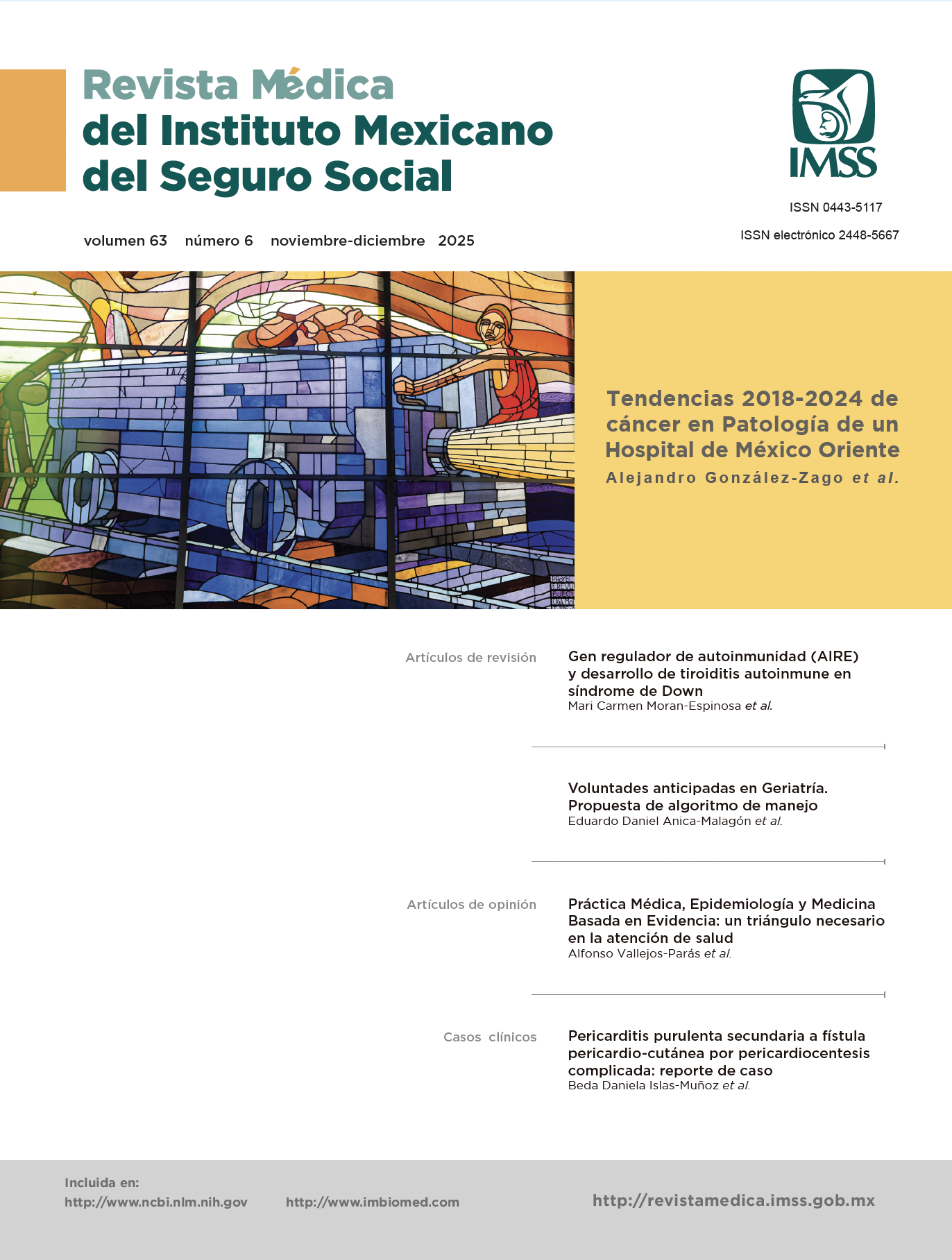2018-2024 Cancer Trends in Pathology of a Hospital in Eastern Mexico
Main Article Content
Keywords
Neoplasms, Epidemiology, Incidence
Abstract
Background: Cancer is one of the leading causes of mortality in both Mexico and the world, and its incidence continues to rise. Therefore, maintaining up-to-date records of cancer diagnoses at both local and national levels is essential.
Objective: To analyze malignant neoplasm diagnoses issued by the Pathology Department of a tertiary care hospital in the eastern region of Mexico.
Material and methods: Observational, descriptive study. Cancer diagnoses registered in the Pathology Department of the Hospital de Especialidades, Centro Médico Nacional “General de División Manuel Ávila Camacho,” in Puebla, Mexico, were analyzed for the period 2018–2024.
Results: Since 2018, a higher number of cases have been observed in women, accounting for 60–64% of total diagnoses. In 2024, the most frequent cancers in the general population were breast, prostate, and skin cancer. Among women, the most common were breast, thyroid/parathyroid, and skin cancers, while in men, prostate, kidney, and skin cancers predominated. A significant increase in diagnoses was recorded in 2024, particularly for breast, thyroid/parathyroid, colorectal, ovarian, kidney, and lung cancer in women, and for prostate, kidney, colorectal, bladder, and thyroid/parathyroid cancer in men.
Conclusions: Access to regional cancer diagnosis data in Mexico is essential for establishing effective strategies for cancer control, early detection, and timely treatment.
References
1. Global Burden of Disease 2019 Cancer Collaboration. Cancer Incidence, Mortality, Years of Life Lost, Years Lived With Disability, and Disability-Adjusted Life Years for 29 Cancer Groups From 2010 to 2019: A Systematic Analysis for the Global Burden of Disease Study 2019. JAMA Oncol. 2022;8(3):420-44.
2. Padilla-Raygoza N, Monroy-Torres R, Sandoval-Salazar C, et al. Cancer prevention programmes in Mexico: are we doing enough? Ecancermedicalscience. 2020;14:997. doi: 10.3332/ecancer.2020.997.
3. Villarreal-Garza C, Aranda-Gutierrez A, Gonzalez-Sanchez DG, et al. National cancer control plans in Latin America and the Caribbean: challenges and future directions. Lancet Oncol. 2025;26(6):e320-e30. doi: 10.1016/S1470-2045(25)00039-7.
4. Flamand-Gómez L, Moreno-Jaimes C, Arriaga-Carrasco R. Cáncer y desigualdades sociales en México. Primera edición. Ciudad de México, México: El Colegio de México; 2021. 120 p.
5. Instituto Nacional de Estadística y Geografía. Estadísticas de Defunciones Registradas (EDR). [Comunicado de Prensa 45/25]. México; 2025 Febrero. 5p. Disponible en: https://www.inegi.org.mx/contenidos/saladeprensa/boletines/2025/edr/EDR_En-sep2024.pdf
6. Bray F, Møller B. Predicting the future burden of cancer. Nat Rev Cancer. 2006;6(1):63-74. doi: 10.1038/nrc1781.
7. Bray F, Laversanne M, Sung H, et al. Global cancer statistics 2022: GLOBOCAN estimates of incidence and mortality worldwide for 36 cancers in 185 countries. Cancer J Clin. 2024;74(3):229-63. doi: 10.3322/caac.21834.
8. Instituto Nacional de Estadística y Geografía. Estadísticas a Propósito del Día Mundial Contra el Cáncer [comunicado de prensa 39/25]. México; 2025. 7 p. Disponible en: https://www.inegi.org.mx/contenidos/saladeprensa/aproposito/2025/EAP_DMvsCancer25.pdf
9. Instituto Nacional de Estadística y Geografía. Estadísticas a propósito del Día Mundial contra el Cáncer [comunicado de prensa 78/24]. México; 2024. 7 p. Disponible en: https://www.inegi.org.mx/contenidos/saladeprensa/aproposito/2024/EAP_CANCER24.pdf
10. Gutiérrez-Arzapalo PY, Gutiérrez-Grijalva EP. Factores de Riesgo Asociados al Incremento de Cáncer en México. REVMEDUAS. 2024;14(2):110-2. doi: 10.28960/revmeduas.2007-8013.v14.n2.001.
11. Islami F, Marlow EC, Thomson B, et al. Proportion and number of cancer cases and deaths attributable to potentially modifiable risk factors in the United States, 2019. Cancer J Clin. 2024;74(5):405-32. doi: 10.3322/caac.21858.
12. Reynoso-Noverón N, Chang S, Herrera-Montalvo LA, et al. Cancer Prevention Behaviors in Workers of a Referral Cancer Center in Mexico City: A Pilot Study on Early Detection Awareness for Cancer. CCX. 2022;29:10732748221133625. doi: 10.1177/10732748221133625.
13. Goddard KAB, Feuer EJ, Mandelblatt JS, et al. Estimation of Cancer Deaths Averted From Prevention, Screening, and Treatment Efforts, 1975-2020. JAMA Oncol. 2025;11(2):162-7. doi: 10.1001/jamaoncol.2024.5381.
14. Rodríguez-Reyes SC, Rico-Fuentes C, Pereira-Suárez AL, et al. Nutrition and Diet in the Prevention and Management of Prostate Cancer in Mexico: A Narrative Review. Nutrients. 2025;17(13). doi: 10.3390/nu17132151.
15. Barragan-Carillo R, Asirwa FC, Dienstmann R, et al. Global Oncology: Tackling Disparities and Promoting Innovations in Low- and Middle-Income Countries. Am Soc Clin Oncol Educ Book. 2025;45(3):e473930. doi: 10.1200/edbk-25-473930.
16. Reynoso-Noverón N, Torres-Domínguez JA. Epidemiología del cáncer en México: carga global y proyecciones 2000-2020. Rev Latinoam Med Conducta / Lat Am J of Behav Med. 2018;8(1):9.
17. Rivera-Luna R, Olaya-Vargas A, Velazco-Hidalgo L, et al. El abrumador problema del cáncer infantil en México. Acta Pediatr Méx. 2024;45(5):503-10. doi: https://doi.org/10.18233/apm.v45i5.2964.
18. Leal YA, Torres J, Gamboa R, et al. Cancer Incidence in Merida, Mexico 2015-2018: First Report from the Population-based Cancer Registry. Arch Med Res. 2022;53(8):859-66. doi: https://doi.org/10.1016/j.arcmed.2022.11.015.
19. Velásquez-Paz AL, Azamar-Cruz E. Epidemiología descriptiva del cáncer en adultos atendidos en el Hospital Regional de Alta Especialidad de Oaxaca: experiencia de 10 años. Avan Cien Sal Med. 2019;6(1):16-22.
20. Perez-Irigoyen N, Roque-Flores A, Vadillo-Alvarado AE, et al. Cancer epidemiology in pathology of a hospital in eastern Mexico. Rev Med Inst Mex Seguro Soc. 2024;62(2):1-8. doi: 10.5281/zenodo.10711749.
21. Smolarz B, Łukasiewicz H, Samulak D, et al. Lung Cancer—Epidemiology, Pathogenesis, Treatment and Molecular Aspect (Review of Literature). Int J Mol Sci. 2025;26(5):2049. doi: 10.3390/ijms26052049,
22. Kwak SH, Kim CY, Lee SH, et al. Updates on lung cancer screening for early detection. Korean J Intern Med. 2025;40(4):546-56. doi: 10.3904/kjim.2025.008.
23. Arceo-Martinez MT, Lopez-Meza JE, Ochoa-Zarzosa A, et al. Estado actual del cáncer de mama en México: principales tipos y factores de riesgo. GAMO. 2021;20(3):101-10. doi: https://doi.org/10.24875/j.gamo.21000134.
24. Mendoza-López A, Téllez-Bernal E, Alonso-Martínez JC, et al. Incidencia de tumores malignos en pacientes adultos, diagnosticados por primera vez en el hospital Instituto de Seguridad y Servicios Sociales de los Trabajadores al Servicio de los Poderes del Estado de Puebla en el año 2014. GAMO. 2016;15(2):59-65. doi: https://doi.org/10.1016/j.gamo.2016.02.005.
25. Téllez-Bernal E, Fernández-Tamayo NM, Trejo-Rivas AA, et al. Incidencia de tumores malignos en pacientes adultos diagnosticados por primera vez en el hospital Instituto de Seguridad y Servicio Social al Servicio de los Trabajadores del Estado de Puebla en el año 2013. GAMO. 2015;14(2):75-8. doi: https://doi.org/10.1016/j.gamo.2015.06.014.


